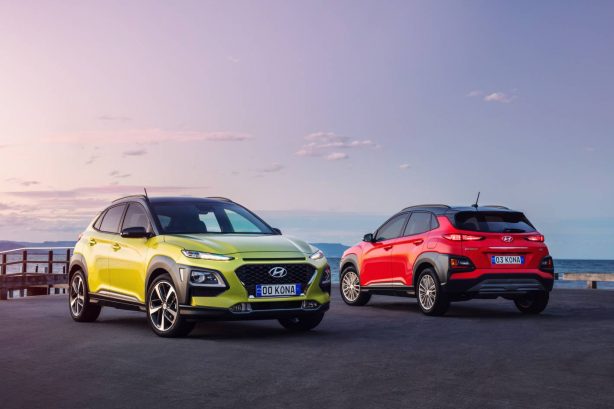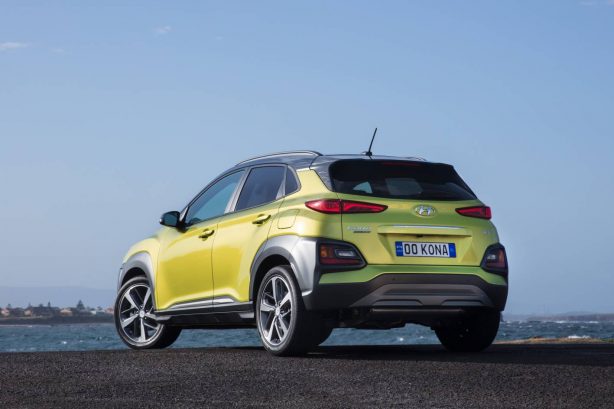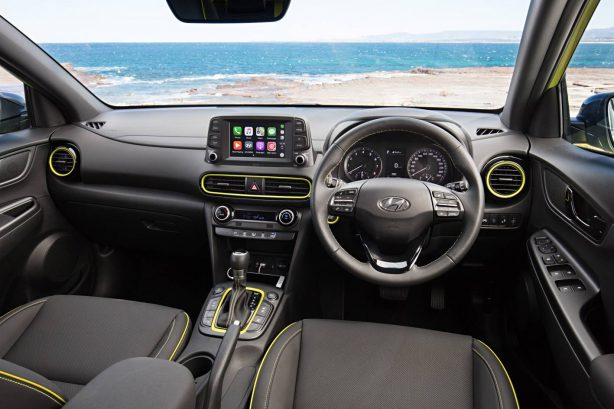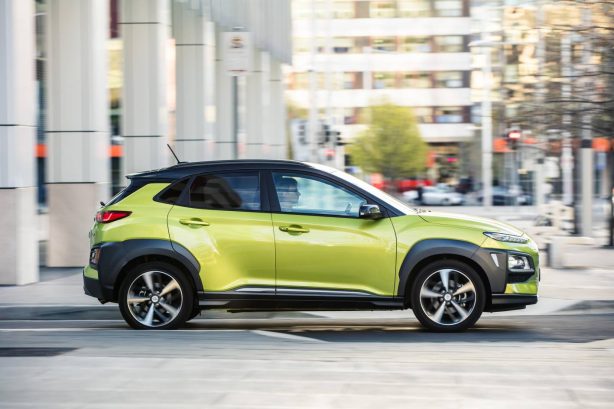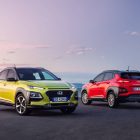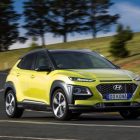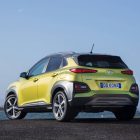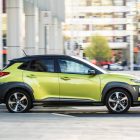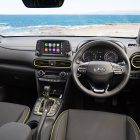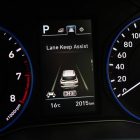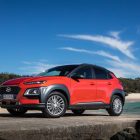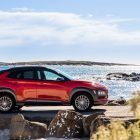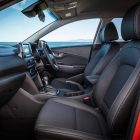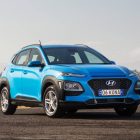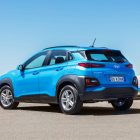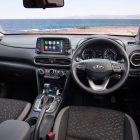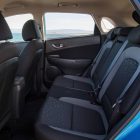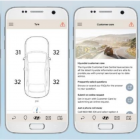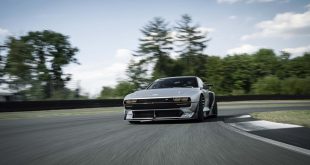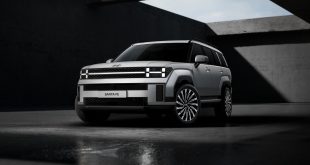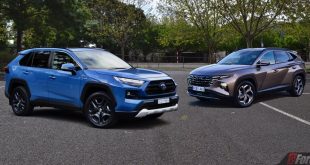Hyundai has unveiled its all-new Kona small SUV into one of the most popular segments in Australia, joining the brand’s bigger Tucson and Santa Fe SUVs.
The Kona is said to be developed to meet both the rational and emotional needs of its buyers and neatly blends the key elements required of such a vehicle, with dynamic and expressive design and advanced safety and technology features.
It also sets a new standard with its advanced levels of safety and technology and its engineering excellence ensures it hits the sweet spot, with passenger car-like driving dynamics and SUV practicality, without losing any of the comfort or cargo space demanded by its customers.
Featuring an advanced platform design and dynamic, stand-out styling, new Kona is one of the most compact vehicles in its class, shorter and lower than most of its rivals but also wider than many and with a substantial wheelbase and short front and rear overhangs. It comes to market with modest dimensions but it is one of the roomiest.
“Arriving fashionably late for the party means that Hyundai Motor Company has had the development time needed to deliver a small SUV that is right for its time and laser-focused on its target,” said Hyundai Motor Company Australia Chief Executive Officer, Mr JW Lee.
“Kona boasts a multitude of innovative safety and technological features across a solid model range, featuring engines and transmissions that will appeal to a wide customer base and a wonderful level of customization built in – and all of it balanced by keen pricing, a five-year, unlimited kilometre warranty and Lifetime Service Plan.
“Kona will appeal to customers with active lifestyles, a sense of adventure and a keen eye for value,” he said.
Kona boasts premium safety and luxury features right across the model range with, for example, accessible smartphone connectivity and the latest pedestrian safety technology.
In a first for Hyundai, the Kona features the brand’s Auto Link, which connects the car’s computer to the driver’s mobile phone offering everything from real-time vehicle diagnostics, to driving history statistic, parking management (vehicle location and parking time reminders), easy service scheduling and automatic access to roadside assistance if required.
The Kona is named after Hawaii’s “Kona Coast” region which is famous among thrill-seeking travellers. Hyundai says that energetic image is reflected in the innovative, practical and highly functional design of the lifestyle-focused Kona.
The new Kona will be available in three trim levels, Active, Elite and Highlander, with an optional safety pack for Active.
ENGINES AND DRIVETRAINS
Kona will be available with two engine and transmission packages for Australia, buyers getting a choice across the range of either a 2.0-litre, naturally-aspirated, four-cylinder engine with conventional six-speed automatic and front-wheel-drive, or a 1.6-litre Turbo-GDI with seven-speed dual-cutch transmission (DCT) and all-wheel-drive.
The 2.0-litre ‘Nu’ engine features multi-point fuel-injection (MPi) and Atkinson Cycle technology to deliver improved fuel economy through greater thermal efficiency, without any loss of power and torque.
For Kona the engine produces 110kW at 6,200rpm and 180Nm at 4,500rpm. Paired with the six-speed automatic transmission, it accelerates the front-wheel-drive Kona from standstill to 100km/h in a claimed 10 seconds flat.
The 2.0 litre MPi engine is mated to Hyundai’s own six-speed automatic transmission with a multi-plate clutch torque converter and sequential manual mode.
Hyundai’s 1.6-litre ‘Gamma’ four-cylinder engine features gasoline-direct injection (GDi) and a mixed-flow turbocharger. It produces 130kW at 5,500rpm 265Nm of torque from 1,500rpm and stays at its peak through to 4,500rpm.
The ‘Gamma’ 1.6 T-GDi has 18% more power and 47% more torque than the 2.0 litre MPi engine, giving a 7.9 second 0-100km/h time.
The turbo engine is mated to Hyundai’s seven-speed, dual-clutch transmission (DCT).
Drive Mode Select is available on both automatic and DCT variants, the function letting drivers choose between ‘Comfort’, ‘Eco’ and ‘Sport’ modes.
READ MORE: 2018 Hyundai Kona Review
Hyundai Kona pricing (excluding on-road costs):
| Engine | Drivetrain | Active | Active with Safety Pack | Elite | Highlander |
| 2.0 MPi Petrol | 6-speed automatic 2WD | $24,500 | $26,000 | $28,500 | $33,000 |
| 1.6 T-GDi Petrol | 7-speed DCT AWD | $28,000 | $29,500 | $32,000 | $36,000 |
| Option pricing | Active | Active with Safety Pack | Elite | Highlander |
| Premium paint | $595 | $595 | $595 | $595 |
| Two tone roof | – | – | $295 | $295 |
Specification overview:
Kona Active
- 6 airbags
- LED DRL
- Downhill Brake Control (DBC)
- Hill-start Assist Control (HAC)
- Auto dusk sensing headlights
- Electronic Stability Control (ESC)
- Rear park assist system
- Rear view camera
- Tyre pressure monitoring system
- 16” alloy wheels
- 7” multimedia system
- Apple CarPlay and Android Auto
- Bluetooth connectivity
- 5” TFT colour supervision cluster
- Leather appointed steering wheel and knob
- Cruise control
- Hyundai Auto Link
- Roof Rails
Kona Active with safety pack
Key specifications above Active:
- SmartSense including:
- Blind-spot collision warning
- Rear cross traffic-collision warning
- Lane keeping assist
- Forward collision warning
- Forward collision-avoidance assist
- Driver attention warning
- Power folding exterior mirrors
- Heated exterior mirrors
Kona Elite
Key specifications above Active with safety pack:
- 17” alloy wheels
- Leather appointed seats
- Smart key & push button start
- Climate control with auto defog
- Solar control glass with rear privacy
- Front fog lights
- Rain sensing wipers
- Driver seat back pocket
- Front passenger seat back pocket
- Carbon grey grille
- Carbon grey exterior cladding
- Side garnish insert
- Skid plate – rear
- Luggage net
Kona Highlander
Key specifications above Elite:
- 18” alloy wheels
- Front park assist system
- LED headlights and front indicators
- LED taillights
- High beam assist
- Head-up display
- Air ventilated front seats
- 2” TFT colour supervision cluster
- Power driver’s and passenger’s seat
- Heated front seats
- Electro-chromatic interior mirror
- Wireless charging pad (Qi standard)
- Heated steering wheel
 ForceGT.com Car News, Car Reviews, Video Reviews, Tuning and much more.
ForceGT.com Car News, Car Reviews, Video Reviews, Tuning and much more. 